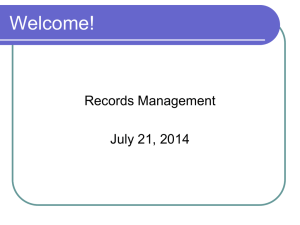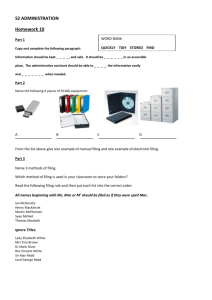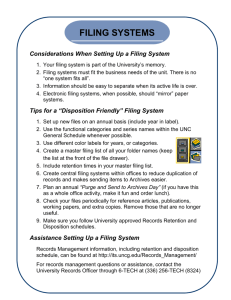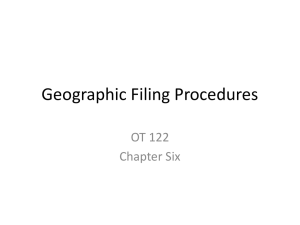Assignment5
advertisement
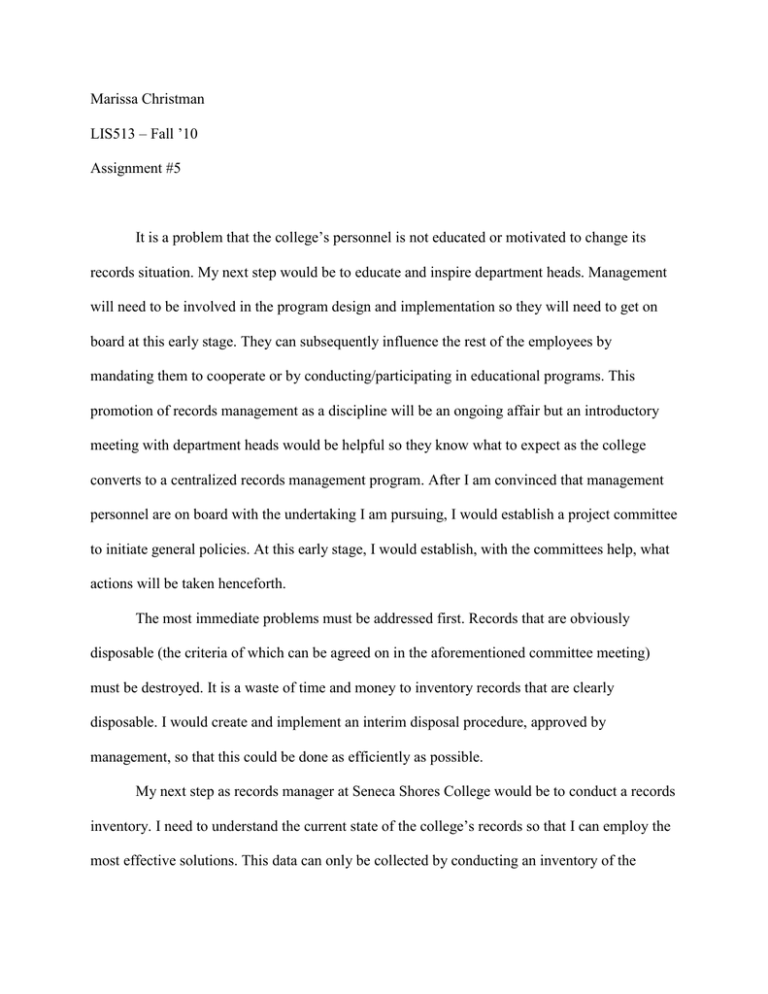
Marissa Christman LIS513 – Fall ’10 Assignment #5 It is a problem that the college’s personnel is not educated or motivated to change its records situation. My next step would be to educate and inspire department heads. Management will need to be involved in the program design and implementation so they will need to get on board at this early stage. They can subsequently influence the rest of the employees by mandating them to cooperate or by conducting/participating in educational programs. This promotion of records management as a discipline will be an ongoing affair but an introductory meeting with department heads would be helpful so they know what to expect as the college converts to a centralized records management program. After I am convinced that management personnel are on board with the undertaking I am pursuing, I would establish a project committee to initiate general policies. At this early stage, I would establish, with the committees help, what actions will be taken henceforth. The most immediate problems must be addressed first. Records that are obviously disposable (the criteria of which can be agreed on in the aforementioned committee meeting) must be destroyed. It is a waste of time and money to inventory records that are clearly disposable. I would create and implement an interim disposal procedure, approved by management, so that this could be done as efficiently as possible. My next step as records manager at Seneca Shores College would be to conduct a records inventory. I need to understand the current state of the college’s records so that I can employ the most effective solutions. This data can only be collected by conducting an inventory of the college’s paper and electronic records. This would be a very labor-intensive, taxing process but it must be done before I can establish and efficient system. After I conduct an inventory, I would need to prepare a needs assessment and present it to people who have authority within the college. I would present the needs assessment to the department heads and to the committee I have created. I would then work with management and other employees to establish a plan of action based on the conclusions that I have reached in the needs assessment. Likely to be at the forefront of this plan of action is the creation and implementation of a comprehensive filing plan for paper and electronic records. Each department would need to subsequently assist me in creating individualized filing plans specific to their office. After these plans are approved by management, they must be implemented. I would need to interact with office personnel and perhaps I could conduct seminars to introduce the new filing plan to the employees who will be responsible for executing them. I would involve the IT department in the implementation of the electronic filing plan. As part of executing the filing plan, I would assist in transferring inactive files to storage. The development office, for example, no longer needs to house the large volume of fundraising records that are rarely referred to. These may be transferred to the storage facility. By this time, I would have a firm grasp on which other files are active and inactive based on the results of the inventory conducted earlier. I would also consider records series that are candidates for digital imaging. One such candidate would surely be the security office’s incident investigation case files. The office can no longer accommodate the volume needed, they are referred to often and they must not be moved. Another good candidate for digital imaging would be the Finance department’s ledgers. They are referred to often and are, presently, difficult to retrieve. For the past 14 years, the ledgers are already in an electronic format, so digitizing the paper ledgers that also referred to often might be a good idea. The electronic versions could possibly be the official version of the ledgers, making the paper copies the preservation copy. The electronic filing plan would help to make these digital files accessible to all who need them but I may, at this time, consider investing in an ECMS. The college seems big enough to make the cost of an ECMS worth it but this step would have to be discussed with management personnel and I would have to conduct a costs/benefits analysis to determine whether an ECMS is the right choice for Seneca Shores. Once the active files are in order and functionality is restored to the department offices, I would initiate the development of a college-wide retention schedule. This would involve the committee of department heads and perhaps additional personnel from each department. Developing a retention schedule is made easier by the information I already have from my records inventory. The retention schedule would establish the difference between records and non-records, establish which records are transferred to storage and which are disposed of after they are no longer needed for reference, as well as establish which stored documents are destroyed and when. At this point, I would inform the director of development that the various publications and printed materials are non-records. Since they are not produced during the normal course of business, they can be disposed of once they are no longer used. At this point I may want to create, propose and impose some document destruction procedures. Once each record series is assigned a retention period, I may create and execute a filing plan for the storage unit. This would involve purchasing storage supplies so that all records are stored in appropriate, like containers. I would also, at this point, install a system to regulate temperature and humidity within the storage units, paying special attention to the units housing permanent records. I would create and implement this filing plan with the understanding that the filing scheme should lend itself well to the retrieval techniques I will need to employ. Thus, the next step would be to create and implement a retrieval system for inactive records.
